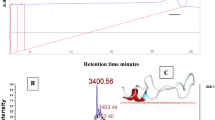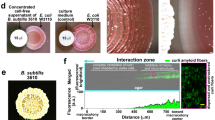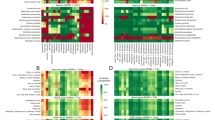Abstract
IN the course of an investigation on the formation of amylase by Bacillus subtilis, it was observed that the organism, when grown on wheat bran medium, showed a pronounced antibiotic activity. The maximum activity was found in the aqueous extract from a 24-hour-old culture. The amylase formation during this period was found to be low, but steadily increased with further incubation. This phenomenon led to a study of the relationship between the antibiotic production and amylase formation by B. subtilis1 (N.C.T.C. : 2027 N) when grown on wheat bran.
This is a preview of subscription content, access via your institution
Access options
Subscribe to this journal
Receive 51 print issues and online access
$199.00 per year
only $3.90 per issue
Buy this article
- Purchase on SpringerLink
- Instant access to full article PDF
Prices may be subject to local taxes which are calculated during checkout
Similar content being viewed by others
References
Lulla, B. S., Ind. Chem. Soc., 25, 119 (1948).
Mohan, R. R., Rao, T. N. R., and Sreenivasaya, M., Curr. Sci., 15, 108 (1946).
Srinivasa Rao, S., Nature, 154, 83 (1944).
Beckord, et al., Indust. Eng. Chem., 37, 692 (1945).
Abraham, et al., Lancet, 241, 177 (1941).
Rao, R. R., and Murti, C. R. K., Curr. Sci., 17. 23 (1948).
Author information
Authors and Affiliations
Rights and permissions
About this article
Cite this article
LULLA, B. Antibiotic Activity as Shown by a Highly Amylolytic Strain of Bacillus subtilis. Nature 163, 489 (1949). https://doi.org/10.1038/163489a0
Issue date:
DOI: https://doi.org/10.1038/163489a0
This article is cited by
-
?ber die antagonistische Beeinflussung von Wachstum und atmung bei einigen h?heren Pilzen
Archiv f?r Mikrobiologie (1953)



